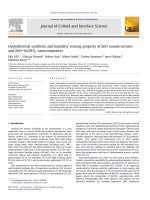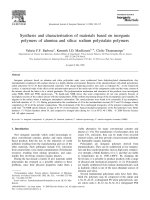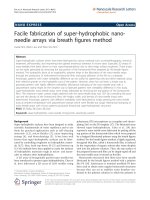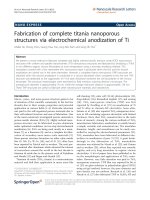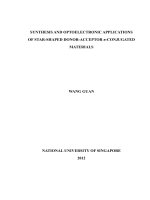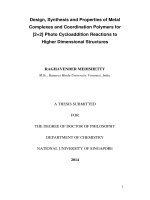Synthesis and fabrication of nanostructional functional polymeric materials via plasma processes and polymer modification
Bạn đang xem bản rút gọn của tài liệu. Xem và tải ngay bản đầy đủ của tài liệu tại đây (6.44 MB, 200 trang )
SYNTHESIS AND FABRICATION OF
NANOSTRUCTURED FUNCTIONAL POLYMERIC
MATERIALS via PLASMA PROCESSES AND POLYMER
MODIFICATION
ZONG BAOYU
NATIONAL UNIVERSITY OF SINGAPORE
2009
SYNTHESIS AND FABRICATION OF
NANOSTRUCTURED FUNCTIONAL POLYMERIC
MATERIALS via PLASMA PROCESSES AND POLYMER
MODIFICATION
ZONG BAOYU
(B. Sci., MBA)
A THESIS SUBMITTED
FOR THE DEGREE OF DOCTOR OF PHILOSOPHY
DEPARTMENT OF CHEMICAL AND BIOMOLECULAR
ENGINGEERING
NATIONAL UNIVERSITY OF SINGAPORE
2009
I
ACKNOWLEDGEMENT
First of all, I wish to express my cordial gratitude to my supervisors, Prof. Kang En-
Tang and Prof. Neoh Koon-Gee, for the heartfelt guidance, valuable suggestions,
profound discussions, and warm encouragements throughout this research work. The
invaluable knowledge, which I have learnt from them on how to do research work and
prepare scientific papers, will benefit me in my future research career.
I would like to thank all my group members and laboratory officers of the Department
of Chemical and Biomolecular Engineering for their kind help and assistance. In
particular, thanks to Dr Xu Fujian, Dr Lin Qidan, Dr Fu Guodong, Dr Yuan Ziliang,
Mr Shang Zhenhua, Dr Shi Zhilong, and Dr Hu Feixiong for their helpful advices and
discussions. It is my great pleasure to work with all of them.
I am deeply grateful for the supports from the top management and my research group
members at the Data Storage Institute of A-Star.
Last but not least, I would like to give my special thanks to my parents, wife,
daughter, and family members for their continuous encouragements.
II
TABLE OF CONTENTS
Acknowledgement ………………………………………….………………………. I
Table of Contents …………………………………………………………….… II
Summary ……………………………………………………….……
V
Nomenclatures ……………………………………………….…………….…… VIII
List of Figures ……………………………………………………………….… XI
List of Tables ……………………………………………………….…………… XVI
Chapter 1 Introduction ………………………………………………………… 1
1.1 Background of Research …………………………………….………. 2
1.2 Research Objectives and Scope … …………… … 5
Chapter 2 Literature Survey ………… ………………….….….……… …… 9
2.1 Fluoropolymers and Plasma Polymerization …………………… 10
2.2 Polymer Modification and Fine Polymer Nanostructures ………… 28
Chapter 3 Synthesis of Highly Hydrophobic Fluoropolymer Films of
Nanospheres via Plasma Polymerization of Fluoromonomers.… 30
3.1 Introduction …… ……………………………………………… 31
3.2 Experimental Section ………………………………… ………… 33
3.3 Results and Discussion ……………………………………………. 35
3.4 Conclusions …………………… ………….………….………… 48
Chapter 4 Porous Fluoropolymer Nanospheres and Thin Film
Prepared via Plasma Polymerization … … 49
4.1 Introduction ……………………………………… …….… 50
4.2 Experimental Section …………………………………… ……… 52
4.3 Results and Discussion …………………….………….………… 54
III
4.4 Conclusions …………………………………………….………. 67
Chapter 5 Magnetic Mesoporous Fluoropolymer Nanospheres from Plasma
Polymerization and Surface-Initializing Adsorption of Magnetic
Nanoparticles … 68
5.1 Introduction ………………………………… … ……….… 69
5.2 Experimental Section ……………………………………….…… 71
5.3 Results and Discussion ………………………… ………………. 73
5.4 Conclusions …………………………… ……………………… 87
Chapter 6 Magnetic Mesoporous Fluoropolymer Nanospheres from Plasma
Polymerization/Etching and Adsorption of Surface-Functionalized
Magnetic Nanoparticles …………… 88
6.1 Introduction ………………………………… … ……….… 89
6.2 Experimental Section ………………………………….…….……91
6.3 Results and Discussion ………………………… ……………….93
6.4 Conclusions ……………………….…………….………… … 106
Chapter 7 Sterically Aligned Fluoropolymer Nanospheres from
Self-Assembly During Plasma Polymerization …………………. 107
7.1 Introduction ………………………………… ….……….… 108
7.2 Experimental Section …………………………… …….… … 110
7.3 Results and Discussion ………………………… ……… ……. 112
7.4 Conclusions …………………………… ………………… … 126
Chapter 8 0 - 3 Dimensional Conductive and Magnetic Nanostructures
Prepared from Colloidal Polypyrrole Dispersions 127
8.1 Introduction ………………………………… ….……….… 128
8.2 Experimental Section …………………………… ………….… 130
8.3 Results and Discussion ………………………… ……… ……. 135
8.4 Conclusions …………………………… ……………… …… 151
IV
Chapter 9 Conclusions and Recommendation for Future Work …… …… 152
References…………………………………………………….……………… … 157
List of Publications …………………………………………………………… 182
V
SUMMARY
Plasma processes and polymer modification are two versatile tools for the fabrication of
polymer nanostructures and nanopatterns. Nanostructures of functional polymers, such as
fluoropolymers, electroactive polypyrrole (PPY), and others, can be prepared potentially
via plasma processes or polymer modification. The aim of this work was to develop
simple and novel methods for the fabrication of fine polymer nanostructures and
nanopatterns from fluoromonomers and pyrrole via plasma polymerization, plasma
etching, or polymer modification. It was also the objective of this work to explore useful
functionalities and potential applications for these nanostrutured polymers after
characterization.
Initially, via plasma polymerization and deposition at room temperature, highly
hydrophobic fluoropolymers were synthesized by exploring various polymerization
parameters, such as the wide range of system pressures (13 – 107 Pa) and glow discharge
powers (100 – 400 W), and the natures of fluoromonomers of different boiling points (b.
p.), molecule weight (MW), and degree of saturation. Mesoporous fluoropolymer
nanospheres were prepared via the agglomeration of fine poly(heptadecafluorodecyl
acrylate) (pp-HDFA) nanoparticles from plasma polymerization and deposition.
Relationships between particle size and glow discharge duration during the high energy
plasma polymerization of the HDFA monomer were elucidated. With these mesoporous
nanospheres, a series of ultra-thin (< 100 nm) and low dielectric
constant nanoporous
films were obtained by means of one-round or multiple pulse plasma polymerizations. In
addition, by carefully controlling the monomer concentrations and polymerization
parameters, two-dimensionally and three-dimensionally self-assembled pp-HDFA
VI
nanospheres on hydrogen-terminated Si(100) (H-Si) wafers were fabricated in dry
ambience. The morphology of horizontally aligned particles could be changed from
particle ‘chains’ to particle ‘bars’ by reducing the particle distribution density on the
wafer surface. The vertically assembled nanoparticles in the form of pyramids were
obtained under a very low initial monomer concentration and the effect of the electric
field in the reaction chamber. Furthermore, by carefully controlling the input plasma
power, system pressure, and glow discharge duration, mesoporous
polypentafluorostyrene (pp-PTFS) nanospheres and films were synthesized from the
PTFS monomer. The porous nanospheres can be used to fabricate magnetic porous
nanospheres upon thermal-decomposition of the adsorbed pentacarbonyl iron.
By using the two different plasma functions (viz. plasma polymerization and plasma
etching) in a plasma system, mesoporous fluoropolymer nanospheres of 200 - 300 nm in
size were prepared directly via one-pot plasma polymerization and deposition, followed
by controlled argon plasma dry etching. The porous fluoropolymer nanospheres can be
used as substrate to adsorb PtFe nanoparticles, and thus imparting magnetic functionality
on the mesoporous nanospheres.
Finally, via polymer modification in wet process, functional micro- and nano-structures
from conductive aqueous PPY colloidal dispersions were created. The stable PPY
colloidal dispersions were prepared via oxidative polymerization of pyrrole by FeCl
3
in
the presence of surfactants in an aqueous medium. Zero to three dimensional (0 - 3D)
PPY nanostructures, such as 0D nanoparticles, 1D nanofibres, 2D nanofilms, and 3D
nanoflowers were fabricated by casting, coating, or spraying. When using these PPY
VII
nanospheres as substrates, magnetic CoFe shell/conductive PPY core nanospheres,
hollow magnetic CoFe nanospheres, and conductive microspheres with magnetic handles
were also prepared.
VIII
NOMENCLATURE
0 – 3D Zero to three dimension
AFM Atomic force microscope
BEs Binding energies
b. p. Boiling point
CAP mechanism The principle of competitive ablation and polymerization
D. C. Direct current
D
m
Particle size (mean particle diameter)
EDX Energy dispersive X-ray
FESEM Field emission scanning electron microscope
FTIR Fourier transform infrared spectroscopy
HDFA Heptadecafluorodecyl acrylate
HFB Hexafluorobenzene
H-Si wafer Hydrogen-terminated silicon wafer
IC Integrated-circuit
IPA Isopropanol or 2-Propanol
κ Dielectric constant
M Molarity or molar concentration
(units: mol/L)
M-H loop Magnetization-hysteresis loop
MW Molecular weight
NaDS Sodium dodecyl benzene sulfonate
OLED Organic light-emitting-device
IX
PCB Printed circuit board
PET Polyethylene terephthalate
PFH Perfluoroheptane
PFS 2,3,4,5,6- Pentafluorostyrene
pp-HDFA Plasma polymerized heptadecafluorodecyl acrylate
pp-HFB Plasma polymerized hexafluorobenzene
pp-PFH Plasma polymerized perfluoroheptane
pp-PFS Plasma polymerized pentafluorostyrene
PPY Polypyrrole
pp-Zonyl
TM
Plasma polymerized Zonyl
TM
PVA Poly(vinyl alcohol)
R
a
Average surface roughness
RF Radio frequency
sccm Standard cubic centimeter per minute
SD Standard deviation
SIA Semiconductors Industry Association
TEM Transmission electron microscopy
Tg Glass transition temperature
ToF-SIMS Time-of-flight secondary ion mass spectrometry
X
VSM Vibrating sample magnetometer
W/FM Composite parameter in plasma polymerization,
where:
W - RF power (in J/s),
F - monomer flow-rate (in mol/s),
M - molecular weight of monomer (in kg/mol)
XPS X-ray photoelectron spectroscopy
XI
LIST OF FIGURES
Chapter 3
Figure 3.1 FESEM images of (a) pp-PFS and (b) pp-Zonyl
TM
polymer films
deposited at a system pressure of 80 Pa, RF power of (1) 100 and (2) 400
W.
Figure 3.2 AFM images of (a) pp-PFH and (b) pp-HFB films deposited at RF power
of 400 W and different pressures of (1) 27, (2) 80, and (3) 107 Pa.
Figure 3.3 AFM image of pp-Zonyl
TM
film obtained at monomer temperature of (a)
25 or (b) 60°C on Si substrate with room temperature, or (c) 25°C on Si
substrate with high temperature of 78°C, under a RF power of 400 W and
system pressure of 13 Pa.
Figure 3.4 FTIR reflectance spectra of (a) pp-PFS and (b) pp-Zonyl
TM
films
deposited at 80 Pa. The RF powers for pp-PFS are 100, 300, and 400 W
while for pp-Zonyl
TM
50, 100, 200, and 400W.
Chapter 4
Figure 4.1 Scheme for the fabrication of porous polymer nanospheres and film via
plasma polymerization and deposition.
Figure 4.2 3 × 3 μm 2D AFM images of pp-HDFA nanospheres deposited at a
system pressure of 7 Pa with various glow discharge duration: (a) 3, (b)
10, (c) 20, and (d) 30 s.
Figure 4.3 3 × 3 μm 2D AFM images of pp-HDFA nanoparticles polymerized at a
system pressure of 13 Pa with various glow discharge duration. (a)-(f)
stands for 3, 10, 20, 30, 60, and 120 s, respectively.
Figure 4.4 pp-HDFA nanospheres polymerized under RF power of 500 W at a
system pressure of 7 Pa by plasma-glow-discharge of 55 s. (a) 3 × 3 μm
AFM 3D image and (b) 0.5 × 0.5 μm 2D AFM topographical image. (c)
FESEM image (scale bar: 10 nm) of one big nanosphere in (b).
Figure 4.5 ToF-SIMS spectra of the pp-HDFA nanospheres deposited at a system
pressure of 7 Pa with various glow discharge durations.
XII
Figure 4.6 (a
1
) and (b
1
) are 3 × 3 μm 3D AFM images of porous pp-HDFA films
polymerized under RF power of 500 W at a system pressure of 13 Pa by
plasma-glow-discharge of 38 s for one and four rounds, respectively. (a
2
)
FESEM laternal view image of (a
1
) porous film on Si wafer. The inset is
a high magnification FESEM image at a magnification of 250,000×
(scale bar = 30 nm). (b
2
) FESEM image of a porous pp-HDFA film via
multiple depositions. The scale bar is 100 nm.
Chapter 5
Figure 5.1 Fabrication scheme of magnetic porous polymer nanospheres via plasma
polymerization, surfactant-initiated surface adsorption, and thermal
decomposition.
Figure 5.2 AFM image of pp-PTFS (a) solid particles prepared under a system
pressure of 27 Pa and RF power of 200 W with a plasma discharge
duration of 60 s. (b) Mesoporous films prepared under a system pressure
of 13 Pa and glow discharge power of 500 W with a glow discharge time
of 20 s. The inset in (b) is a 200 × 200 nm FESEM image. (c)
Mesoporous films compiled nanospheres synthesized under a system
pressure of 13 Pa and glow discharge power of 400 W with a plasma
discharge duration of 60 s.
Figure 5.3 (a) FESEM image of pp-PTFS porous nanospheres prepared under a
system pressure of 27 Pa and RF power of 400 W with glow discharge
time of 20 s. The inset is a TEM image focusing on a nanosphere. The
scale bar is 50 nm. (b) AFM image of pp-PTFS mesoporous
nanospherical film deposited via 4 rounds of multi-plasma
polymerization under the same polymerization parameters as (a).
Figure 5.4 High-resolution XPS C 1s core-level spectra of pp-PTFS nanostructured
polymers deposited under different polymerized parameters. (a) solid
particles, (b) porous nanospheres, (c) porous film.
Figure 5.5 (a) FESEM images of one porous pp-PTFS nanosphere with immobilized
iron oxide nanoparticles. (b) TEM image of one part of ~300 nm
pp-
PTFS nanosphere loaded with iron oxide nanoparticles. The scale bars of
(a) and (b) are 100 and 20 nm, respectively. (c) and (d) are the respective
VSM and EDX analysis results of the magnetic nanospheres on a 10 × 8
mm Si substrate. In (c), the open symbol (-◊-) and solid symbol (-■-)
stand for the magnetic moment of the mesoporous pp-PTFS nanospheres
prior to and after immobilization of the iron oxide nanoparticles,
XIII
respectively. (e) TEM image of one part of a magnetic pp-PTFS
nanosphere after HCl washing.
Chapter 6
Figure 6.1 Scheme illustrating (a) the preparation of mesoporous fluoropolymer
nanospheres via plasma polymerization and plasma etching, (b) the
preparation of surface-functionalized PtFe nanoparticles, and (c) the
adsorption of magnetic PtFe nanoparticles on the porous polymer
nanospheres.
Figure 6.2 FESEM images of (a) solid pp-HDHF particles polymerized under an
input RF power of 200 W, system pressure of 40 Pa and glow discharge
time of 45 s, and the solid particles after (b) 5 s and (c) 22 s of Ar plasma
etching under the same RF power and system pressure. The scale bars in
the images of parts (a) and (b) are 1 µm, and of part (c) is 100 nm, while
the scale bars for the 3 insets are 100 nm.
Figure 6.3 ToF-SIMS spectra of the pp-HDFA spheres (a) before and (b) after 8 s of
plasma etching.
Figure 6.4 XPS wide scan spectra and C 1s core-level spectra of the pp-HDFA
spheres before etching (a, b) and after 5 s (c, d) and 8 s (e, f) of plasma
etching.
Figure 6.5 Images of a porous pp-HDFA nanosphere (from 5 s of plasma etching of
the solid nanosphere) with adsorbed magnetic PtFe nanoparticles: (a)
FESEM image, (b) TEM image. The scale bars in (a) and (b) are 100 and
20 nm, respectively.
Figure 6.6 VSM analysis results of a 250-nm thick layer of the magnetized pp-HDFA
nanospheres on a 5 × 3 mm
2
Si substrate. The open symbol (-◊-) and
solid symbol (-■-) stand for the magnetization of the mesoporous pp-
HDFA nanospheres prior to and after adsorption of the PtFe
nanoparticles, respectively.
Chapter 7
Figure 7.1 Schematic illustration of plasma deposition under different glow discharge
conditions.
XIV
Figure 7.2 3 × 3 μm AFM image of (a) the pp-HDFA porous film deposited under a
pressure of 13 Pa, RF power of 400 W, and glow discharge time of 60 s.
(b) and (c) 2D (linearly) aligned pp-HDFA nanospheres chains deposited
under a pressure of 53 and 107 Pa, respectively, RF power of 400 W, and
plasma glow discharge time of 60 s. The plasma chamber was charged
with the HDFA monomer for 60, 30, and 30 s for (a), (b), and (c),
respectively, prior to plasma polymerization.
Figure 7.3 3 × 3 μm AFM image of the 2D aligned pp-HDFA particle bars deposited
under a pressure of 53 Pa and RF power of 400 W, with glow discharge
time of 15 s for (a) and (b) (one round deposition), and (c) (two rounds
deposition). The plasma chamber was feed with the monomer for 20, 15,
and 15 s, respectively, before polymerization. The inset of (b) is a 1 × 1
μm AFM image of the wafer rotated by about 90° before scanning while
keeping the scanning direction of the tip unchanging.
Figure 7.4 3 × 3 μm AFM images of the pp-HDFA particles deposited under a
pressure of 53 Pa and the RF power of 400 W with glow discharge time
of (a) 5, (b) 15, and (c) 40 s, respectively. The plasma chamber was
initially charged with the monomer for 5 s. The inset of (c) is 1 × 1 μm
AFM image, which shows pyramids of ~50 nm nanoparticles.
Figure 7.5 C 1s core-level spectra of the pp-HDFA nanoparticle pyramids (a), and the
nanoparticle pyramids after storing in CO
2
(b) and O
2
, respectively, for
two days.
Chapter 8
Figure 8.1 Fabrication schemes of (a) PPY dispersion, 0D solid PPY nanospheres,
and 1 - 3D nanostructures, (b) PPY core-CoFe shell nanospheres, (c)
hollow magnetic CoFe shell nanospheres, and (d) magnetic PPY spheres
by means of chemical oxidation polymerization, magnetic film
sputtering, and solution treatment processes.
Figure 8.2 FESEM images of (a) PPY nanospheres synthesized via drop-wise
addition of PPY dispersion into acetone under stirring at a speed of 1000
rpm, (b) PPY nanowires prepared via casting PPY dispersion into
alumina filter, baking, and dissolving the alumina filter, (c) PPY
nanowires synthesized via casting of liquid PPY dispersion into acetone
through an alumina filter with a pore size of 150 nm, (d) PPY porous
film fabricated via sprinkling PPY and acetone solution onto Si wafer
surface and drying under reduced pressure, (e) PPY flat film prepared via
spin-coating PPY dispersion on Si wafer and drying in air, and (f) PPY
XV
nanoflowers synthesized via sprinkling PPY and H
2
O mixture on Si
wafer, followed by cooling in liquid N
2
and drying under reduced
pressure. The scale bars in the images of (a) and (b) are 100 nm; (c), (e)
and the inset of (f) are 1 µm; (d) and (f) are 10 µm.
Figure 8.3 FESEM images of (a) a thick layer of PPY nanospheres laid on Si wafer
surface, (b) one layer of PPY nanopheres on Si wafer surface prepared
via spin-coating for 20 s at a speed of 2000 rpm, (c) magnetic CoFe
shell/conductive PPY core nanospheres, (d) and (e) hollow magnetic
CoFe nanospheres. The inset is a TEM image, and (f) magnetic handle
microspheres. The scale bars in the FESEM images of (a), (b) and inset
of (f) are 1 μm, (c)-(e) are 100 nm while (f) is 10 µm. The scale bars for
the TEM image in the inset of (e) is 5 nm.
Figure 8.4 XPS wide scan spectra of the solid conductive PPY nanostructures: (a)
planar film from drying PPY dispersion in air, (b) porous film from
drying the mixture of PPY dispersion and acetone under reduced
pressure, and (c) solid nanospheres from drop-wise addition of PPY
dispersion into acetone under vigorous stirring.
Figure 8.5 EDX results of (a) PPY nanospheres, (b) hollow magnetic CoFe
nanospheres, (c) handle of magnetic PPY microsphere, and (d) 3D PPY
nanoflower.
Figure 8.6 PPY nanosensor measurement circuit (a) and measurement results (b). In
(b), the line ( ) stands for sensor results without any addition (before
150 s) and addition of liquid toluene (at 150 s), while ( ) and ( )
stand for addition of liquid N
2
or acetone, and addition of distilled water
then acetone, respectively.
XVI
LIST OF TABLES
Chapter 3
Table 3.1 Chemical structures and properties of the 4 monomers.
Table 3.2 Surface morphological properties of 4 fluoropolymer films obtained at
different RF power and system pressure on the Si substrates.
Table 3.3 Water contact angles for the 4 fluoropolymer surfaces.
Chapter 4
Table 4.1 Assignments of positive ions in the ToF-SIM spectra of the pp-HDFA
nanospheres.
Table 4.2 Physical properties of the transparent porous pp-HDFA films deposited via
polymerization and deposition at input RF power of 500 W.
Chapter 5
Table 5.1 Property comparisons of the pp-PTFS polymers deposited at different
plasma (RF) energy.
Table 5.2 Assignments of positive ions and ToF-SIMS spectra of pp-PTFS.
Chapter 6
Table 6.1 Assignments of the positive ion fragments in the ToF-SIMS spectra of pp-
HDFA nanospheres.
Table 6.2 XPS results of pp-HDFA nanospheres before and after Ar plasma etching.
Table 6.3 EDX analysis results of magnetized pp-HDFA nanospheres.
Chapter 7
Table 7.1 Physicochemical properties of the pp-HDFA nanostructures.
Chapter 8
Table 8.1 Physicochemical properties of conductive PPY dispersion and
nanostructures.
Chapter 1
1
CHAPTER 1
INTRODUCTION
Chapter 1
2
1.1 Background of Research
Preparation of nano-/micro-structured polymers and innovative applications of these
polymers are two recent objectives in polymer science. Nanostructured organic materials
are of increasing importance in microelectronics, bioactive-device, nanotechnology,
semiconductor industry, and other advanced technologies. For example, in order to match
the increasing memory capacity and faster processing speed of computers, continuous
development of highly integrated microchips requires the semiconductor industry to
evolve towards electronic devices with ever decreasing feature dimensions on each chip
[Callister et al., 2003; Sermon et al., 2004]. Hence, ultra-low dielectric constant (κ)
interlayer films are essential in the new generation of high density integrated circuits (IC)
for reducing the time delay, cross-talk, and power dissipation of the resistive capacitance
in electronic devices. In this aspect, the widely used silicon dioxide insulator (κ = 3.9 -
4.2) can no longer meet the requirement (κ < 2.5) of the new generation of ultra-large
scale ICs [Yu et al., 2004; Sermon et al., 2004]. Nanostructured fluoropolymers are
potential materials for applications in this area due to their lowest κ values among all the
bulk materials, their good chemical and thermal stabilities, and reasonable costs of
production
[Stevens, 1999; Yasuda, 1990; Inagaki, 1996]. However, fluoropolymer
applications in the sub-micron and nanoscale electronics are hindered by difficulties in
fabrication [Yasuda, 1990; Biederman, 1992]. Fortunately, plasma polymerization is a
simple technique for the deposition of polymer films on a variety of substrates from a
wide range b. p. of monomers and molecules [Mijs, 1992; Biederman, 1992].
Furthermore, plasma polymerization is a convenient way to deposit polymers of
controlled thicknesses and properties. The other merits of polymer fabrication via plasma
Chapter 1
3
processes is the possibility of carrying out the reaction under a wide range of temperature
(including room temperature) in dry ambience and in the absence of a solvent. In
addition, plasma process possesses two inverse functions, viz. plasma polymerization and
plasma etching. Thus, the processing problem of fluoropolymers can be overcome by
plasma processes [Inagaki, 1996; Stevens, 1999]. Furthermore, differing from
conventional methods, through the plasma process in dry ambience, different
morphologies of fluoropolymers involving nano-/micro-structures or nanopatterns can be
synthesized [Shi, 1996]. However, even though plasma process is a simple process, the
parameters in plasma polymerization and deposition, such as plasma power, monomer
concentration, system pressure, chemical and physical properties of the monomers, have
two opposite functions to affect the resulting polymers and the reproducibility. On one
hand, the parameters can significantly affect the morphology, property, and the
reproducibility of the resulting polymers [Shi, 1996; Fu et al., 2003]. On the other hand,
the parameters can also be used as variables for achieving various nanostructured
materials. Currently despite numerous reports on the use of plasma polymerizations for
the synthesis of types of bulk and micro-/submicro-structured fluoropolymers, studies on
how to control the parameters of plasma polymerization and use the two opposite
functions (plasma polymerization and plasma etching) of plasma process to fabricate
nanostuctured fluoropolymers are still of great interest, as few studies and reports are
available in the literature.
Besides the importance of nanoflouropolymers, nanostructured organic electronic
conductors (such as polypyrrole or PPY) are also important polymers in the field of
microelectronics, biotechnology, and nanoprocess [Ghosh et al. 2004; Zou et al., 2001].
Chapter 1
4
In comparison to other conductive polymers, PPY possesses some unique properties,
such as low-toxicity, excellent environment stability, high electrical conductivity, and
interesting redox properties
[Kang et al., 1987; Benseddik, 1998; Saxena and Malhotra,
2003]. Hence conductive PPY nanopolymers have potential applications as electroactive
materials for batteries, capacitors, actuators, membranes, smart windows, and
communication tools in microelectronics [Cawdery et al., 1998; Li et al., 2001; Lu et al.,
2004]. However, nanostructured pyrrole nanopolymers synthesized by chemical or
electrochemical oxidative polymerization are largely intractable
[Makhlouki, 1992;
Saunders, 1999]. Up to now, the synthesized aqueous and non-aqueous colloidal PPY
dispersions face the problems of stability and phase-transfer [Makhlouki, 1992].
Therefore, PPY applications in nanodevice fabrication are currently limited [Benseddik,
1998; Saunders, 1999].
Chapter 1
5
1.2 Research Objectives and Scopes
Based on the developing situations and challenges in the fabrication of fine
nanostructured fluoropolymers and pyrrole polymers, the specific goals of this PhD study
are as follows:
1) To prepare low dielectric constant and highly hydrophobic nanostructured
fluoropolymers from different monomers by controlling the parameters in plasma
polymerization.
2) To develop new techniques of polymer self-assembly in dry ambience for the
preparation of well-defined fluoropolymer nanostructures or nanopatterns.
3) To combine the two different functions of plasma process (plasma polymerization
and etching) as a novel approach for the fabrication of nanoporous fluoropolymers.
4) To prepare stable aqueous colloidal dispersions of conductive PPY, which are
suitable for the fabrication of 0 – 3D functional PPY nanostructures via phase
transfer.
5) To explore new functions and applications for the as-synthesized polymer
nanostructures.
This thesis will focus on plasma process and polymer modification for the fabrication of
various functional nanostructures. The work consists of nine chapters. This chapter
provides a general introduction to the subject. Chapter 2 presents an overview of the
related literature.
Chapter 3 describes the synthesis of highly hydrophobic nanostructured fluoropolymers
on silicon substrates via plasma polymerization and deposition. Four monomers with
Chapter 1
6
different b. p. and chemical structures are used as precursors for the preparation of
polymers under varying glow discharge conditions. From the experimental results, the
influences of the polymerization parameters on the morphologies, properties, and
deposition rates of the resulting polymers will be revealed. The monomers used include
perfluoroheptane (PFH, linear saturated structure), hexafluorobenzene (HFB, contains an
unsaturated aromatic ring), pentafluorostyrene (PFS, contains an aromatic ring and one
unsaturated C=C bond), and Zonyl
TM
fluoromonomer (Zonyl
TM
, linear structure with one
C=C bond).
Chapter 4 states a series of ultra-thin (< 100 nm) and highly porous fluoropolymer films
prepared from the aggregation of mesoporous nanospheres via plasma polymerization
and deposition in a controlled manner. The synthesized mesoporous fluoropolymer
nanospheres have an average size of down to 18 nm, which depends on the plasma-glow-
discharge duration and system pressure. The pore size of the nanospheres was 2 - 6 nm.
The thickness of the thin fluoropolymer films (20 – 100 nm) can be controlled by means
of one-time or multiple pulse plasma polymerizations.
Chapter 5 illustrates simple approach to the synthesis of ordered mesoporous nanospheres
in dry ambience via plasma polymerization and deposition. This method allows
mesoporous fluoropolymer nanospheres and films to be prepared from one monomer
(PFS) under controlled high energy of plasma polymerizations. The synthesized porous
fluoropolymer nanospheres are about 300 nm in size. The pores of the nanospheres were
about 20 nm. After thermal-decomposition of adsorbed pentacarbonyl iron, these
Chapter 1
7
mesoporous nanospheres were transferred to magnetic porous nanospheres, which can
potentially be used in biotechnologies and catalysis as multifunctional delivery tools.
Chapter 6 reports the mesoporous fluoropolymer nanospheres of 200 - 300 nm in size,
prepared directly via one-pot plasma polymerization and deposition of solid
fluoropolymer nanospheres, followed by controlled argon plasma dry etching. Films of
the assembled mesoporous fluoropolymer spheres exhibited an ultra-low dielectric
constant of about 1.7. Adsorption of surface-modified PtFe nanoparticles of about 3 nm
in size onto the mesoporous structure resulted in mesoporous fluoropolymer spheres with
super-paramagnetic properties.
Chapter 7 presents the methodologies for self-assembly of horizontally and vertically
aligned fluoropolymer nanospheres via plasma polymerization and deposition. Two-
dimensionally (horizontally) and three-dimensionally (vertically) assembled
fluoropolymer nanospheres on H-Si(100) wafer can be deposited in a controlled manner.
The direction of the horizontally aligned nanoparticles is along the crystal epitasis line of
the Si(100) substrate. Particles of sizes ranging from 15 to 40 nm are generated at
reduced initial monomer concentration in the glow discharge chamber and by varying the
system pressure. The vertically assembled nanoparticles in the form of pyramids are
obtained at a very low initial monomer concentration and high glow discharge power of ≥
400 W under the effect of the plasma electric field. This self-assembly method can be
potentially applied to the fabrications of other nanopatterns.
Chapter 8 demonstrates methods for preparing 0 – 3D functional micro- and nano-
structures from modified conductive polypyrrole (PPY) colloidal aqueous dispersions.


